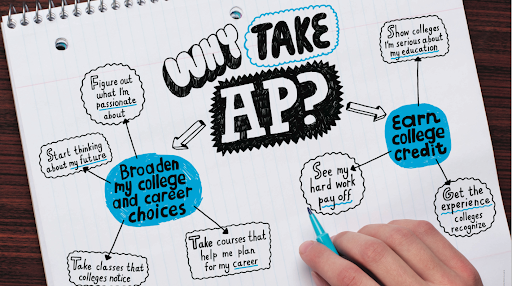What is an AP class?
Students can take an AP or Advanced Placement class instead of a core or elective class.
There are 20 possible AP classes students can take, so any student can find something that they like or are interested in.
Some APs such as US Government and Politics, US History, and US World History take the place of a student’s social studies core class. Other AP classes such as Latin, or Macroeconomics take the place of an elective class.
The order in difficulty of classes rank, academic first, then honors, then advanced placement. AP classes are at a college level and more difficult than their honors or academic counterparts.
Pros
“I take AP Government and Politics right now and it is hard, but even if I get a B I am still getting a higher GPA so I think it is worth it,” said Joey Pinder, sophomore.
Taking an AP class is optional, and students take it to boost their grade point average (GPA), to challenge themselves, or for college credit.
AP classes receive an extra point added to a student’s GPA. For example, if a student gets all A’s in an Academic class, their GPA would be 4.0.
With an AP class, however, an A is counted as 5 points instead of 4. So a possible GPA with all AP classes could be a 5.0 weighted GPA.
A weighted GPA calculates the differences in classes. For example, if a student had 2 academic classes and 2 APs, their highest GPA could be 4.5.
Another reason students take these AP classes is for college credit.
“ You can get college credits so that you would not have to take as many classes in college,” said Issac Rivas, sophomore.
Being able to get college credits in high school leaves the possibility of reducing the amount of time spent at college. If students take enough AP classes, they could take a year needed off of college which would help reduce costs for families.
AP classes taken at Leesville are free. They take care of the fees on the final test so that any student can take any AP class.
Final exam
The final exam is one of the most important parts of an AP class. The final is at the end of the year by the college board but is taken at the school.
College Board is a program that creates tests such as AP classes or the SAT. This program gives teachers the curriculum to teach the class and administers the AP tests at the end of the year.
The final exam consists of 5 possible scores. It ranks from 0-5, 0 being the lowest and 5 being the highest. If a student gets a 3 or above on the final test, they receive a college credit. This can help reduce future stress for students.
Cons
Taking a college-level course is very difficult. The heavy workload can sometimes be overwhelming and stressful for students trying it out. The excess amount of homework, projects, and tests is challenging to many students.
Some AP’s will not be helpful for a students future career path, so it is a possibility that the AP class was unnecessary extra work.
“I was in an AP class for around a week to test it out but I could not do all of it so I switched out of it into the honors class,” said Theo Hill, sophomore.
My experience
I am currently taking AP Government and Politics. It is challenging, but the main point of the class is just to prepare us for the final exam.
The final exam happens in May for most AP classes. So for example, if you take a class in the first semester like AP Gov, you have to take the final at the end of the second semester which can be very difficult. This is hard because you have to remember as much information as you can months after taking the class.
This difficult class has helped with my time management because I learned that I cannot be on my phone all day because then I would get no work done. Because of my personal experience, my soft skills are being improved.
Conclusion
In conclusion, there are benefits to taking an AP class, but students must take in account the difficulty of these types of classes. People must be able to balance everything else in addition to this class.

Leave a Reply